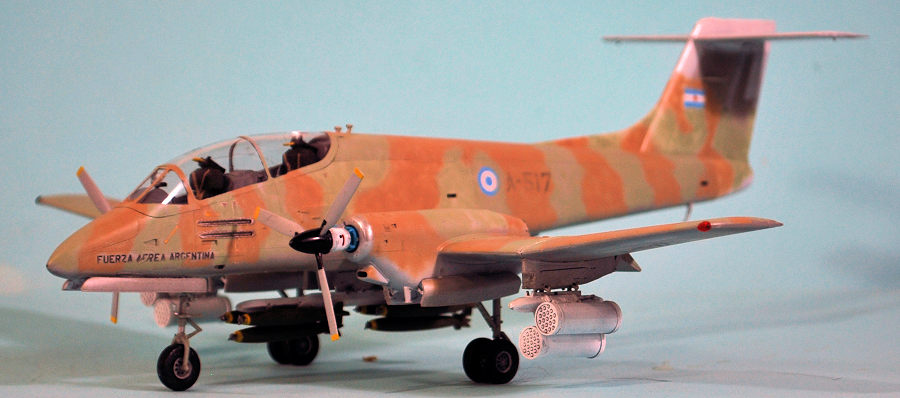
Kinetic 1/48 IA.58 Pucara
| KIT #: | K38078 |
| PRICE: | $39.95 |
| DECALS: | Two options |
| REVIEWER: | Tom Cleaver |
| NOTES: | Hasegawa Weapons Set |

| HISTORY |
The FMA IA 58 Pucará - the name is from the Quechua language, meaning “Fortress,” referring to a form of South American stone hill fortress. The aircraft was designed and built by the Fábrica Militar de Aviones in response to an RFP for a ground-attack and counter-insurgency aircraft. It is the only aircraft of indigenous South American design to see major combat against a Western power.
In August 1966, Dirección Nacional de Fabricación e Investigación Aeronáutica (DINFIA), the Argentine state aircraft factory began development of the AX-2, a Counter-insurgency (COIN) aircraft to meet a requirement of the Fuerza Aérea Argentina (FAA). The project was promoted by Ricardo Olmedo and was designed by Anibal Dreidemie, who also designed the IA-52 Guaraní II and the IA-63 Pampa. The aircraft first flew in 1969, and 107 examples were produced between 1974 and 1999.
The two man crew of two was seated under the upward opening clamshell canopy using Martin- Baker Mk 6AP6A zero/zero ejection seats and both seats are provided with controls and good visibility. Armor is fitted to protect the crew and engines from ground fire. The aircraft is powered by a pair of Turbomeca Astazou engines, driving three-bladed Ratier-Forest 23LF propellers, which are capable of being used as air brakes. Designed for operations from short, rough airstrips, the retractable tricycle landing gear has a single nosewheel and twin mainwheels which retract into the engine nacelles. The Pucará is faster than the OV-10 Bronco, another COIN aircraft.
Fixed armament consists of two Hispano 804 20 mm cannons mounted under the cockpit with 270 rounds each and four 7.62 mm Browning FN machine guns mounted on the fuselage sides below the cockpit with 900 rounds each. Three hardpoints are fitted for carrying external stores. The under-fuselage pylon can carry a load of 1,000 kg (2,200 lb) while the pylons under the wings can carry up to 500 kg (1,100 lb), with total external weapons load limited to 1,620 kg (3,570 lb).
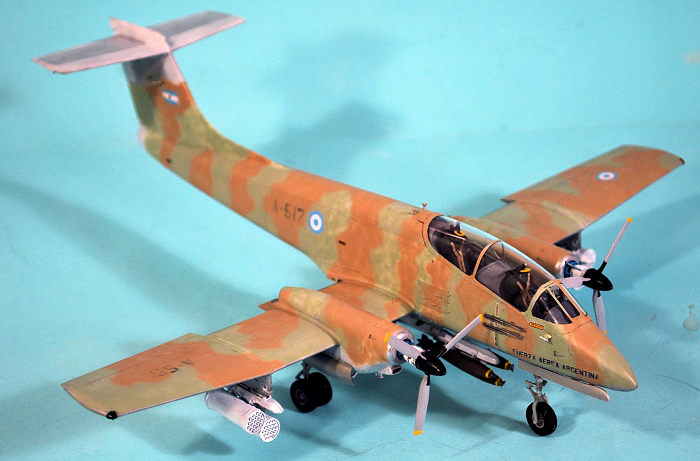 The first aircraft were delivered in May 1975 to the FAA, equipping the
2° Escuadron de Exploración y Ataque, part of the III Brigada Aérea in northern
Reconquista, Santa Fe province. They were first used in 1975, carrying out
counter-insurgency strikes from Córdoba against Communist ERP guerillas in
Tucumán Province as part of Operativo Independencia.
The first aircraft were delivered in May 1975 to the FAA, equipping the
2° Escuadron de Exploración y Ataque, part of the III Brigada Aérea in northern
Reconquista, Santa Fe province. They were first used in 1975, carrying out
counter-insurgency strikes from Córdoba against Communist ERP guerillas in
Tucumán Province as part of Operativo Independencia.
The FAA had 60 Pucarás by the time of the Falklands War in April-June 1982, of which 25 were deployed to three airfields on the islands. All the Falklands based Pucarás were either destroyed in combat or captured by British forces. One of the few aircraft in the FAA capable of operational missions from the small airfields in the Falklands, it was decided to deploy Pucarás to the Falklands, with four arriving at Port Stanley on April 2, 1982, with eight more arriving on April 9.Another 13 were sent from the mainland on May 7 following the arrival of British forces in the Falklands. Pucarás operated from Port Stanley airport and two small improvised grass airfields at Goose Green and Pebble Island, where they were used in the reconnaissance and light-attack role.
Three Pucarás were destroyed and one of their pilots killed at Goose Green by cluster bombs dropped by 800 NAS Sea Harriers on May 1, 1982. Six more were destroyed in the SAS Raid on Pebble Island on May 15, 1982.
On May 21 a Pucará was shot down by the first Stinger SAM used in combat, fired by D Squadron SAS. A was shot down by Commander Nigel Ward, flying a Sea Harrier. Ward observed no fewer than 20 cannon hits before the target fell. A second Pucará piloted by Lt Juan Micheloud escaped after being chased by Lt Commander Alasdair Craig. Major Carlos Tomba, the pilot of the aircraft shot down by Ward, survived the ejection and was recovered by friendly forces. On May 28, the Type 21 frigate HMS Arrow destroyed two Pucaras at Goose Green with naval gunfire.
The same day, two Pucarás shot down a Royal Marines Scout helicopter while it was on a casualty evacuation mission during the battle of Goose Green, for he only confirmed Argentine air-to-air victory of the war. A Pucará was shot down by 2 PARA with small arms fire after mad a rocket attack on British troops that did not cause any casualties during the Battle of Goose Green. Lt Miguel Cruzado ejected and became a POW.
Of the 24 Pucarás deployed to the Malvinas, three were shot down, while six were damaged in accidents and not repaired due to lack of resources. Eight others were damaged and two destroyed due to enemy ground action. Four were captured intact and taken to the UK after the war.
During the peak of the Falklands War in May, the FAA, in collaboration with the Navy, outfitted a prototype, AX-04, with pylons to mount Mark 13 torpedoes. The aim was its possible production as torpedo-carrying aircraft to enhance the anti-ship capabilities of the Argentine air forces. Several trials were performed off Puerto Madryn, over Golfo Nuevo, but the war ended before the technicians could evaluate the feasibility of the project.
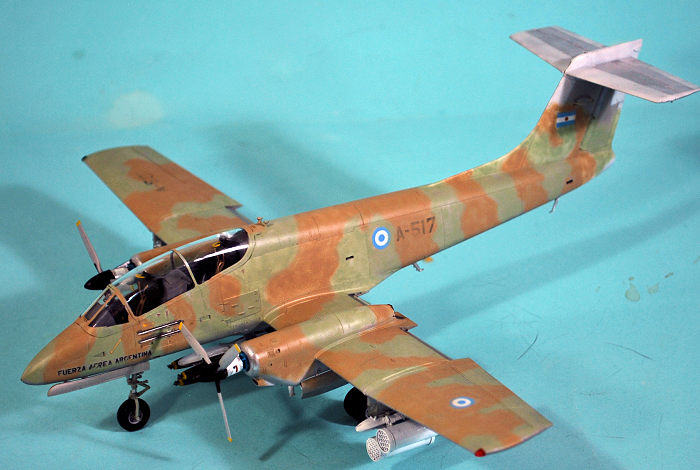 Several attempts were made to upgrade the entire fleet, including the
Pucará Charlie conversion, Pucará 2000 and Pucará Bravo; modernization of 40
units was ordered and later cancelled by the FAA, only one unit was converted.
These were cancelled during the 1980s due to shortage of funds.
Several attempts were made to upgrade the entire fleet, including the
Pucará Charlie conversion, Pucará 2000 and Pucará Bravo; modernization of 40
units was ordered and later cancelled by the FAA, only one unit was converted.
These were cancelled during the 1980s due to shortage of funds.
In 2007 an IA-58 of the Argentine Air Force was converted to carry a modified engine operating on soy-derived bio-jet fuel. The project, financed and directed by the Secretaría de Ciencia Tecnología e Innovación Productiva de la Nación, made Argentina the second nation in the world to propel an aircraft with biojet fuel.
Since 2009 an extensive upgrade of the avionics and major overhaul of the airframes has been carried out by the FAA and FAdeA, creating the IA-58D “Pucará Delta,” with a new PT6A-62 950shp instead of the original Turbomeca Astazou. The overhaul will keep Argentinian Pucarás active until 2045. Fábrica Militar de Aviones is in the process of modernizing twenty of the Argentine Air Force's fleet of Pucaras as intelligence, surveillance and reconnaissance (ISR) duties, renaming the type IA-58 Fenix (Phoenix).
Several attempts were made at selling the Pucará internationally. The Islamic Air Force of Mauritania contracted for four IA-58A planes plus support and training with another eight units optioned. Following a coup d'état, the contract was cancelled. The aircraft were ready to ship, but were incorporated to the FAA as A-515 to A-518. In March 1983, a contract with the Central African Republic Air Force was cancelled. In September 1983, the Venezuelan Air Force fordered 24 IA-58A equipped with Garrett TPE331-11-601W turboprop engines, but the order was canceled when the US provided OV-10A Broncos from USAF stocks. A contract with the Iraqi Air Force for 20 IA 58s with an option for 20 more was canceled due political foreign issues. The Bolivian Air Force contracted for 12 IA-58As but the contract fell through over finance issues. The Iranian Islamic Air Force negotiated a contract for 60 IA-58A and a second for 50 more but this was also canceled. In 1987, six Pucarás were ordered by the Force Aérienne Zairoise, with the contract cancelled over finance. A 1990 contract for 30 IA 58s with the Brazilian Air Force was canceled in favor of the Embraer EMB 314 Super Tucano.
| THE KIT |
It is interesting that modelers have had to wait 40 years after the Pucará became well known outside of Latin America to have a mainstream injection-molded kit of the airplane hit the market. Prior to the arrival of Kinetic’s new kit, Special Hobby released a 1/72 kit, and an Argentine “garage” company, Aconcagua, released a limited-run resin kit in 1/48.
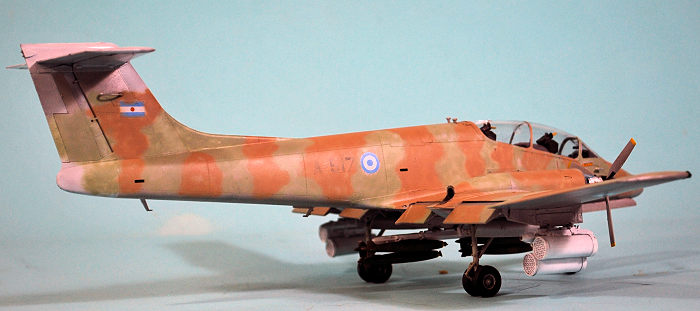 This new IA 58 kit is Kinetic’s best release yet. It is well-designed
with petite surface detail with a cockpit that is a bit sparse from photos but
quite acceptable, with a very clear bubble canopy, detailed landing gear and
separate flaps. No ordnance is provided, though the kit includes TERs for the
underwing pylons. Those modelers who have the Hasegawa Weapons Set A and B can
arm the model with six Mk. 81 250-lb bombs on a MER mounted on the centerline
pylon and two LAU-3s on each of the underwing MERs and have the “standard”
weapon load the airplanes used during the Falklands/Malvinas War.
This new IA 58 kit is Kinetic’s best release yet. It is well-designed
with petite surface detail with a cockpit that is a bit sparse from photos but
quite acceptable, with a very clear bubble canopy, detailed landing gear and
separate flaps. No ordnance is provided, though the kit includes TERs for the
underwing pylons. Those modelers who have the Hasegawa Weapons Set A and B can
arm the model with six Mk. 81 250-lb bombs on a MER mounted on the centerline
pylon and two LAU-3s on each of the underwing MERs and have the “standard”
weapon load the airplanes used during the Falklands/Malvinas War.
Decals are provided for A-511, the Pucará on display in the UK, and an IA 58 operated by the Uruguayan Air Force with a very attractive animal face on the nose. The only other decals for the IA 58 available in 1/48 are in the Aconcagua resin kit which includes markings for all the airplanes in the war. Perhaps with this release, Aconcagua will release that decal sheet separately.
| CONSTRUCTION |
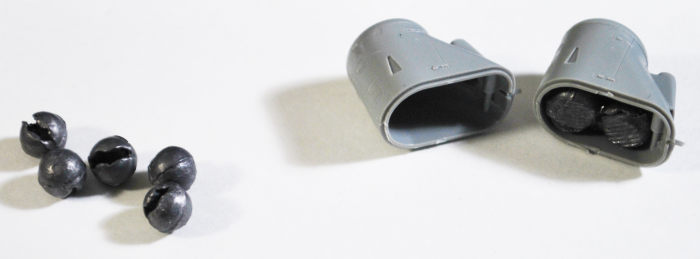 One look at the Pucará’s configuration, with that long rear fuselage
behind the main gear, tells you it’s going to need more weight to be a
nose-sitter. Fortunately, due to the kit design with the forward end of the
engine nacelles being separate, I was able to cram in six squashed “cannon ball”
fishweights in each, and another 10 under the cockpit behind the nosewheel well.
As a result the airplane nose sits, but it will tail sit with just a tap of the
finger. I advise you to put a few more weights under the cockpit floor if you
want a confirmed nose-sitter.
One look at the Pucará’s configuration, with that long rear fuselage
behind the main gear, tells you it’s going to need more weight to be a
nose-sitter. Fortunately, due to the kit design with the forward end of the
engine nacelles being separate, I was able to cram in six squashed “cannon ball”
fishweights in each, and another 10 under the cockpit behind the nosewheel well.
As a result the airplane nose sits, but it will tail sit with just a tap of the
finger. I advise you to put a few more weights under the cockpit floor if you
want a confirmed nose-sitter.
As I say in other reviews, if you commit the revolutionary act of following the instructions, the result will be a very nice model. Construction starts with the cockpit, which I painted overall medium grey, with black instrument panels with the detail picked out with a white art pencil in accordance with some cockpit photos found on the internet. The Martin- Baker Mk 6AP6A seats are OK, which is a good thing since this is a relatively-rare seat and no one has made a resin version (trust me, I searched). I painted these in accordance with a color photo of the seat found on the internet.
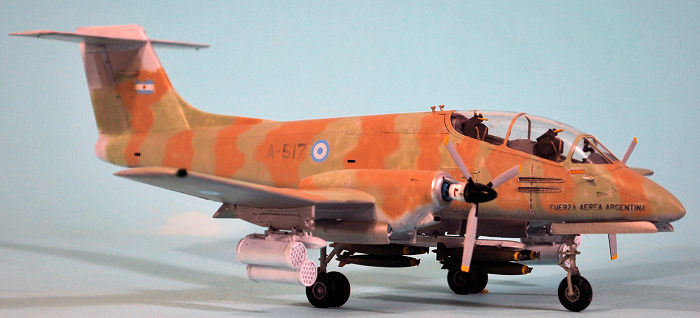 I installed the cockpit tub and the nose gear well and assembled the
fuselage. Fit overall is excellent, though - as with all modern kits - a modeler
is well-advised to be absolutely certain to cut all sprue nubs off and insure a
smooth mating surface. If you do this throughout, you will not need filler
anywhere to deal with seams.
I installed the cockpit tub and the nose gear well and assembled the
fuselage. Fit overall is excellent, though - as with all modern kits - a modeler
is well-advised to be absolutely certain to cut all sprue nubs off and insure a
smooth mating surface. If you do this throughout, you will not need filler
anywhere to deal with seams.
I assembled the main gear wells and attached them in the nacelles on the one-piece lower wing, then attached the upper wing parts and the forward end of the nacelles. Do not attach the prop assembly until after you have painted the model. I also left off the flaps (as with most kits designed with lowered flaps, raising them is difficult but possible if you are determined). I then assembled the wing and fuselage sub-assemblies and attached the horizontal stabilizers.
| COLORS & MARKINGS |
I recommend the book “The Pucará Story,” by Dr. Ricardo Caballero and Phil Cater, published by Mushroom Model Publications, which has every bit of information a modeler could desire, including accurate painting instructions for each of the 24 airplanes that saw combat.
The kit includes decals for the airplane in the Cosford Museum in the UK. The paint scheme is the one used on all the airplanes sent to the islands after the initial four, and following it will present no difficulties for a modeler. I used Tamiya XF-78 “Wooden Deck Tan” and XF-21 “Sky” lightened with 10 percent XF-2 “Flat White” for the upper camouflage colors.
The gear wells and interior of the gear doors were painted with Tamiya X-2 “Gloss White.” The gear legs were painted with Tamiya XF-14 “J.A. Grey” which seems close to the light blue-grey-green color the originals are painted.
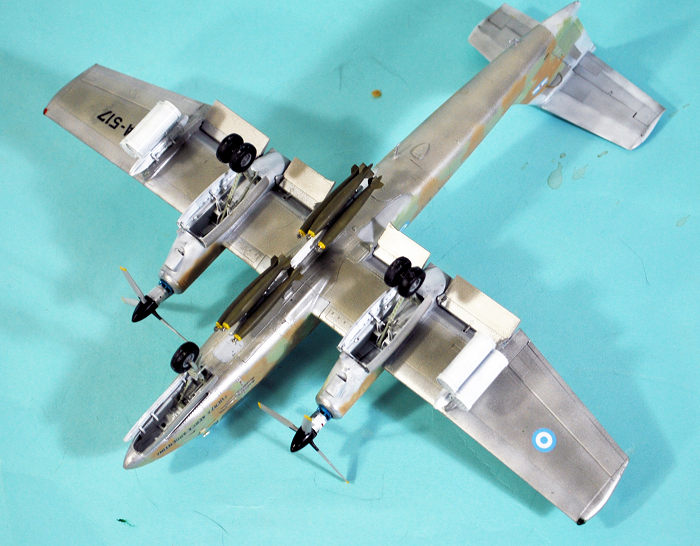 However, after doing some research and finding that the first Pucarás
sent to the islands on April 2, 1982, were in their original anodized finish,
and were then “field painted” with their tails left unpainted due to not having
ladders tall enough to get to the top of the T tail, I opted to do one of these.
(Sane modelers will do the scheme provided in the kit, which was used on all the
airplanes that were painted on the mainland prior to being sent to the islands).
This was accomplished using a base color of Tamiya XF-16 “Flat Aluminum,” mixed
with varying amounts of XF-2 Flat White, XF-83 Sea Grey Medium, and XF-78
“Wooden Deck Tan” to get the various panel shades. This took about six hours of
masking for about a total of 15-20 minutes of air brushing. (You have been
warned, should you decide to do this)
However, after doing some research and finding that the first Pucarás
sent to the islands on April 2, 1982, were in their original anodized finish,
and were then “field painted” with their tails left unpainted due to not having
ladders tall enough to get to the top of the T tail, I opted to do one of these.
(Sane modelers will do the scheme provided in the kit, which was used on all the
airplanes that were painted on the mainland prior to being sent to the islands).
This was accomplished using a base color of Tamiya XF-16 “Flat Aluminum,” mixed
with varying amounts of XF-2 Flat White, XF-83 Sea Grey Medium, and XF-78
“Wooden Deck Tan” to get the various panel shades. This took about six hours of
masking for about a total of 15-20 minutes of air brushing. (You have been
warned, should you decide to do this)
I then applied the decals, subsituting a “7" I found in the decal dungeon to make “A-517" which it turns out was damaged when the nose wheel hit a soft spot in the grass runway at Goose Green taxying in from its second mission, and was used as a decoy for the rest of the war.
The upper camouflage colors were thinned 50-50 and applied sloppily as the photos showed had been done on the real items. The airplanes were painted with Fiat auto paint, so the final finish was semi-gloss. I painted around the national insignia, with overspray of the serials on the fuselage and wing as shown in a photo.
I assembled the landing gear and attached it, then attached the flaps. I unmasked the canopy. The ordnance came from the Hasegawa Weapons Set A for the bombs and centerline MER and the Weapons Set B for the LAU-3 pods.
| CONCLUSIONS |
This is Kinetic’s best kit they’ve ever released. Everything fits perfectly. Take care in assembly and you will not use filler or putty anywhere. Recommended for any modeler willing to follow the assembly instructions. I really liked this project and for once, the final result was very close to the original hope.
25 March 2021
Copyright ModelingMadness.com. All rights reserved.
Review kit courtesy of Kinetic. Order yours from Kintetic’s outlet, Lucky Model
If you would like your product reviewed fairly and fairly quickly, please contact the editor or see other details in the Note to Contributors.